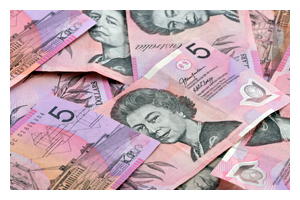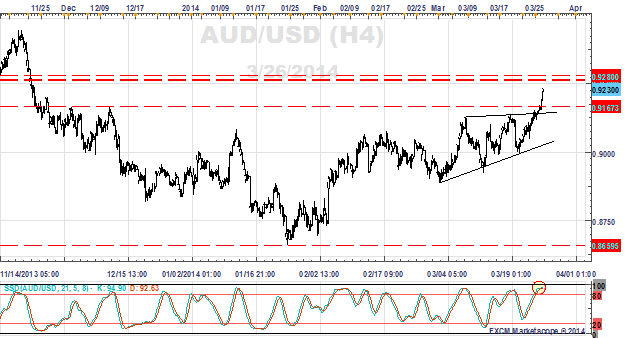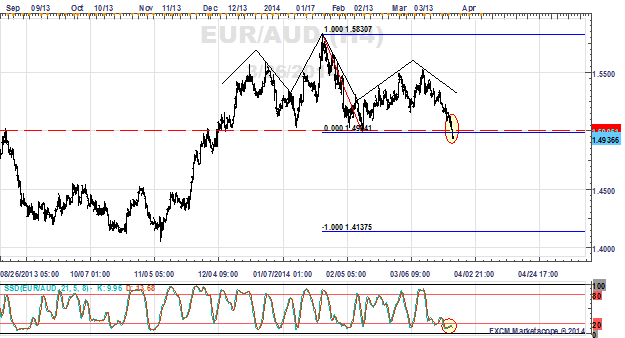
Talking Points:
- Australian economic data is near its apex for 2014.
- The Reserve Bank of Australia wants a weaker currency, doesn’t mean they’ll get it.
- Aussie looks to bottom versus British Pound, Euro, and US Dollar.
The Australian Dollar (AUD) was easily one of the most disliked currencies headed into 2014, after a significantly disappointing performance from April 2014 and forward, including the AUD/USD pair. As many analysts (including this one) sharpened their knives for another dismal performance by the Aussie in 2014, something funny happened: the fundamental conditions present for Australian Dollar weakness disappeared faster than most expected.
The Australian Dollar’s underperformance through the end of last year can be best explained two-fold: first, concern that a slowing Chinese economy alongside failure by the Australian economy to rebalance away from its mining activities would create significant damage; and two, the drawdown in the Federal Reserve’s QE3 stimulus program would dampen the demand for the carry trade.
While the Chinese economy may be slowing (as seen by the recent HSBC PMI Manufacturing report), economic data out of Australia has been roundly better than expected. The Citi Economic Surprise Index was holding up at +49.7 by March 24, just off the yearly high seen on March 13 at +50.6. Considering where this economic data-sentiment index was in mid-January at -19.0, it’s evident that domestically, the Australian economy is performing much better than anticipated.
One of the areas analysts were most concerned with – the labor market – has had a much stronger start to 2014 than recent trends would indicate. At +47.3K net jobs growth in February, the Australian economy added the most jobs since March 2012. This figure was well-above the 3-, 6-, and 12-month jobs averages of +13.7K, +10.7K, and +5.3K; in fact, with the short-term averages above the longer-term ones, it seems the Australian labor market is gaining momentum.
The recent shift if the fundamental factors underpinning the Australian economy may be offering a veritable turning point in the Australian Dollar more specifically, especially against the Euro and the US Dollar.
AUD/USD H4 Chart

The AUD/USD’s recent ascending triangle formation resolved itself to the upside the past two days, and a longer-term inverse head and shoulders bottoming pattern may be the long-term play. Several former levels that proved as resistance in months (.9085, 0.9140, 0.9165/70) past have been broken, showing that the supply of sellers at these levels have been fully neutralized – the path of least resistance may now be here.
EUR/AUD H4 Chart

While the AUD/USD rally may be setting up, there is evidence of further Australian Dollar strength elsewhere. The EUR/AUD, one of the top performers from November 2013 through January 2014, appears to have carved out a topping pattern, a head and shoulders formation. The EUR/AUD has become more negative since we looked at this pair on Monday, and the break of the neckline near 1.5000 sees the potential for a greater drop towards 1.4140 over the coming weeks.
Ultimately, the ensuing actions by the Reserve Bank of Australia will help dictate how far the Australian Dollar can rebound. In recent weeks, RBA Governor Glenn Stevens has spent a good deal of his time in public disparaging the high AUD/USD exchange rate, noting that the RBA would prefer for it to be closer towards 0.8500.
But with evidence of the domestic economy improving, expectations for a dovish RBA have started to wane. Overnight index swaps pointing to +16.0-bps priced in over the next 12-months, suggesting the market is already looking ahead of a rate hike in the late-3Q or 4Q’15. The Australian Dollar may be looking ahead too, as it looks primed to shake 2013’s negativity and head into the 2Q’14 on the heels of potential bullish reversal patterns.
--- Written by Christopher Vecchio, Currency Analyst
To contact Christopher Vecchio, e-mail [email protected]
Follow him on Twitter at @CVecchioFX
To be added to Christopher’s e-mail distribution list, please fill out this form
Visit our Australian Dollar page to read more news on the AUD
original source






 Indonesia
Indonesia